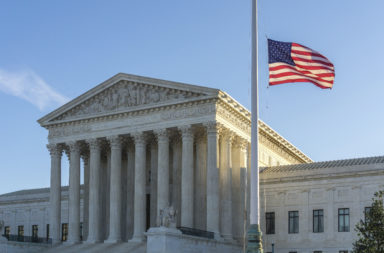Trump administration officials have now laid out their broad-brush ideas for tax reform, essentially claiming that the large tax cuts that primarily help businesses and the wealthy American households would pay for themselves via a burst of economic growth.
- Plan was almost entirely ripped from campaign proposals and concentrates on reducing rates for corporations and high earners.
- Points out who will benefit, but not who will see taxes rise to offset the other cuts.
- It remains to be seen how the Trump administration plans to recoup the losses.
The idea is trickle-down economics, whereby you give tax cuts to businesses and the already affluent in the hope that they will take that extra money and invest in their companies and hire more people.
Of course, they could always just choose not to, and pocket the extra change. Which is precisely what has happened every time this economic “theory” has been put to the test.
The announcement was billed by President Trump as “massive tax reform”, but in typical Trump fashion, the proposal contained almost no detail, and was merely a single-page of bullet points that was sent out minutes before a brief press conference held by Treasury Secretary Steven Mnuchin and top Trump economic adviser Gary Cohn.
This “broad-brush overview” as Cohn called it, was apparently not further detailed as administration officials were still discussing the details of the plan which would have to be translated into legislation and passed through Congress before taking effect.
This isn’t a plan. It’s a skimpy press release. They got us again. pic.twitter.com/xI3A9vokSC
— Matt Phillips (@MatthewPhillips) April 26, 2017
“They are telling them all the good news,” says Michael Graetz, a tax law professor at Columbia University, “but there must be some bad news for someone.”
Tax cuts for businesses
Where there were the ‘most’ details was on the topic of the steep tax cuts for business. As presented, the White House proposal appears to call for cutting taxes on U.S. corporate income to 15 percent from 35 percent. But that’s about where the detail stops.
This broad-brush policy makes determining the cost of the proposed tax cuts very difficult, but the best guess of the Committee for a Responsible Federal Budget is that Trump’s proposals could cost $5.5 trillion.
Trump’s tax plan is a multi-trillion dollar giveaway to giant corporations. And still no $ for Meals on Wheels? Really?
— D Wasserman Schultz (@DWStweets) April 26, 2017
Treasury Secretary Steven Mnuchin called the current 35 percent rate “perhaps the most complicated and uncompetitive business rate in the world.”
What’s important to keep in mind is that while the official corporate tax rate for businesses at 35 percent is higher than for example competitors like Germany (15.8 percent) and the UK (19 percent), nobody pays the full rate. Effective tax was somewhere around 14 percent, according to a 2016 study from the Government Accountability Office.
Pass-through entities
This plan also did not shed light on the reported cut of the top tax rate to 15 percent from 39.6 percent on business income collected by people running owner-operated businesses known as “pass-through entities.”
People that own these companies “pass through” the money they earn from their business, counting it as personal income and reporting it as part of their personal income taxes – and these businesses make up the majority of American entities, roughly 90 percent.
But, only a small percentage of these entities pay the 39.6 percent rate. You only have to pay that rate if you are a married couple earning $470,700 or more ($418,400 for single filers). Who are those people? They’re mostly “hedge fund managers, doctors, lawyers, consultants, and investment managers,” according to an analysis from the left-leaning Brookings Institution.
“Let me be clear: This is for small businesses, not a loophole for rich people to lower their tax bill,” Mnuchin said. Yet at the briefing, he didn’t explain how he could close the loophole.
“That concerns me,” Graetz says. “Those kinds of rules are very difficult to write. I am not sure they’re even possible to write.”
Personal taxes
Unsurprisingly, Trump, who has relatively enormous wealth he is keen to pass onto his children, has called to abolish the estate tax, or death tax. But this is only paid by the super wealthy – married couples you don’t pay the estate tax unless they have an estate valued at more than $10.9 million.
Trump’s plan to eliminate the Estate Tax and provide a $4 billion tax break to the Trump family is especially outrageous.
— Bernie Sanders (@SenSanders) April 26, 2017
Furthermore, Trump also wants to repeal the Alternative Minimum Tax, also mostly just paid by rich Americans. This is the tax that amounted to almost all of the tax that Trump paid in his 2005 return, the only one we have. He paid $31 million specifically due to the AMT, without which his real tax rate would have been around 3 percent.
As far as middle-class families are concerned, the administration said it would consolidate the number of tax brackets from seven down to three, but declined to say the dollar limits that it thought should define the brackets.
The administration also said it would double the standard tax deduction, while doing away with all individual tax deductions, except some a few such as deductions for charitable giving and mortgage interest payments.
The conceit of Trump’s tax plan is it gives wealthy the benefit at front end while promising benefits for lower wage ppl that never come.
— Claude Taylor (@TrueFactsStated) April 26, 2017
Once again, lack of detail makes it very difficult for any given taxpayer to figure out how much it would save them. Asked what the goals laid out by the administration means to middle-class taxpayers, Cohn said simply: “It’s going to mean tax cut.”
Much more information is needed to know if this is true. Mnuchin repeatedly promised the White House plan would “pay for itself,” because the tax cuts will spur so much economic growth that the government will recoup most of the lost money. Yet no budget estimates using that model, known as dynamic scoring, have projected the Trump campaign cuts would produce anywhere close to enough growth to pay for themselves.
Everything you need to know about Trump’s tax plan…
1. Trump is getting a huge tax cut.
2. You aren’t.#yougotplayed— LivingBlue (@LivingBlueinRed) April 27, 2017




